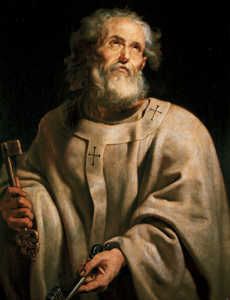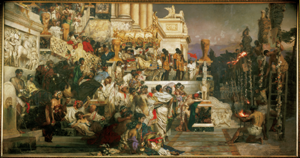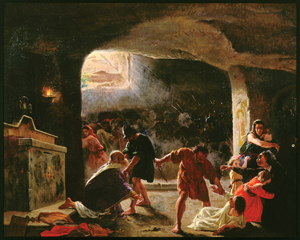
ROME
NOT BUILT IN A DAY

Before Jesus, there were the emperors. When the Christian evangelists, including Paul and the first pope, Peter, arrived in Rome, there were still the emperors. Where Vatican City now exists, emperors such as the notorious Nero persecuted the early Christians. Then, a little more than three centuries after Christ’s crucifixion, everything changed.

UNDERWOOD & UNDERWOOD/HIP/ART RESOURCE, NY
FROM HORRIFIC TIMES is a signal monument seen here in a stereoscopic card detail of St. Peter’s Square. The plaza was designed by Gian Lorenzo Bernini and built between 1656 and 1667. At the center of the plaza stands this ancient Egyptian obelisk dating from the 13th century B.C., which was brought to Rome in the 1st century A.D. by the emperor Caligula to decorate the circus (a sort of stadium) that he developed and that the emperor Nero completed (it was named for him: the Circus of Nero). Many Christians were sacrificed in the Roman arena where the obelisk once stood—on a spot just south of today’s basilica, close to the present sacristy.
Pope Sixtus V had Domenico Fontana move the obelisk to the center of St. Peter’s Square in 1586. A last note: The obelisk, a symbol of whence the Church has come, is also the gnomon of a functioning sundial; its shadow marks the time over zodiac signs inlaid in white marble paving stones within the square. Almost certainly, no other icon associated with Catholicism brings into play polytheistic Ancient Egypt, the virulently anti-Christian Roman Empire and also the zodiac. But there it is, and there it stands.
STATE VERSUS CHURCH

MANSELL/LIFE/THE PICTURE COLLECTION
HE DEMANDED WORSHIP, and above is a marble bust of the despotic and debauched Roman emperor Caligula, the popular nickname for Gaius Julius Caesar Germanicus, who reigned for not quite four years (A.D. 37 to 41) before being assassinated at age 29. Below are ruins of the palace used by his predecessor (and uncle) Tiberius, as well as Caligula.

BETTMANN/CORBIS
What there was of nascent Christianity in his day, Caligula ignored or scorned. The persecutions of those who followed the teachings of Jesus would reach a zenith during the tenures of Caligula’s successors, particularly Nero, who sat on the Roman throne for 13 years between A.D. 54 and 68. They began when evangelists started creeping into the empire’s capital city in the decades after Christ’s crucifixion. One of these proselytizers—the most effective Christ-booster of all—was the zealous convert Paul, a former Jew born Saul of Tarsus, who in his earlier life had been as rough on Christians as any Roman emperor. Below: The Via Egnatia near Philippi, in a part of Macedonia that is today in Greece, where Paul walked during his second missionary journey, which would meet its end in Rome.

ERICH LESSING/ART RESOURCE, NY
PETER AND PAUL

CORBIS
THE FORMER FISHERMAN who would become Saint Peter is seen above in a portrait by Peter Paul Rubens, made circa 1618. Below is the Cave of Pan, near one of the Jordan River’s sources in the vicinity of Mount Hermon. Here, according to the faith, Jesus handed the keys to His kingdom to Saint Peter—the “rock” upon which His Church would be built—and indeed Peter lives on as the first in what is now a line of 266 official popes.

ERICH LESSING/ART RESOURCE, NY
Paul used to be a persecutor of Christians, a thug named Saul ordered by his Jewish bosses to violently break up clandestine gatherings of Jesus-followers that were budding in the Holy Land in the years after the crucifixion. The dead Jesus came to Saul as a voice, asking why Saul was persecuting Him so, and Saul, moved (and healed of blindness), converted, forsaking his Jewish name for his Latin name, Paul.
Peter, by contrast, was a disciple from the beginning. A humble fisherman with, so the Bible implies, a wife (quite a precedent for the papacy!), it was Peter who denied Christ thrice before cockcrow; he hardly looked like the best candidate to lead the flock forward. But as we will see, Jesus knew His man.
Of course, the Roman Empire was all-powerful, at least in the earthly realm, during the time when Peter and Paul, the latter brought forth as a criminal and heretic, arrived in Rome with their conjoined message. It is said that Peter was crucified in the city, and Paul was also executed. Christian traditions hold that Nero might have ordered both deaths.
MAN OF LEGEND

ERICH LESSING/ART RESOURCE, NY
THE STORY OF EMPEROR NERO— Nero Claudius Caesar, who lived from A.D. 37 until A.D. 68—is a fine example of our book’s premise: secrets of the Vatican. Is there any information within the Church’s labyrinthine walls and corridors that would tell us who this man actually was—devil incarnate or mere dictator/despot?—and whether in fact he killed Peter and Paul? There probably is not, not any conclusive evidence that could survive debate. Christians tend to think that Nero had these great saints executed, but even this wasn’t posited generally until long after the fact, in the 4th century. Today’s historians debate just how bad a man Nero was. Most do agree that he was plenty bad at regular intervals, and that he had little use for Christians. He was probably the first emperor who actively persecuted and killed numbers of Christ-followers, putting violent action to sentiments that were harbored by Roman authorities since the days of his forebear Caligula—and even earlier.
Here we see a painting, The Torches of Nero, by Polish artist Henryk Siemiradzki. It is a monumental 19th-century masterwork. It depicts Nero about to have some Christians burned. Historically, he is of course closely associated with fire, most prominently with the Great Fire of Rome in A.D. 64. The dirty theory is that Nero himself ignited the conflagration to clear land needed for a planned palatial estate grander than what existed. Whatever: Rome burned. Nero fiddled or did not. And Nero remained on the throne.
He was a fan of the arts (theater) and of sports, but this does not constitute redemption. Central to his reputation remain the Christians—his treatment of them generally, and perhaps Peter and Paul specifically.
It gets as bad as this, and this is food for thought as we look at Siemiradzki’s painting: Nero had Christian prisoners drenched in oil and set afire to prettify his gardens at night. He also ordered a slew of other executions, including that of his mother and maybe his stepbrother. According to the apocryphal 2nd-century document The Ascension of Isaiah, one who was “the slayer of his mother, who himself (even) this king, will persecute the plant which the Twelve Apostles of the Beloved have planted. Of the Twelve one will be delivered into his hands.” The “one” is interpreted as Peter; and in the 4th century, in his history of the Church, Bishop Eusebius of Caesarea wrote that Paul had been beheaded in Rome during Nero’s reign.
Under pressure, Nero committed suicide in year 68—the first Roman emperor to do so, and well before anyone was dreaming that Rome would one day be overtaken by the Christians.
DEATH AND AFTERMATH
PAUL THE EVANGELIST willfully created his own problems, and once he was writing his letters to the Romans—after those to the Galatians, Corinthians, Philippians and others—he had sealed his own fate. It is believed he arrived in the great city for trial, and there his biography ends. Perhaps nobody in world history has had a more consequential afterlife in the words he left behind than Paul; it has been said by theologians that he, in interpreting Jesus’s teachings and example, was nearly Christ’s equal in creating Christianity.

ERICH LESSING/ART RESOURCE, NY
Whence Peter came is recorded in the New Testament, largely in the Acts of the Apostles, which are canonical texts like Paul’s epistles. Whither Peter went and where he was buried are parts of apocryphal tradition. In fact, there are rumors that he was buried in a Christian cemetery in Jerusalem; that he never made it out of the Holy Land. But over the first two or three centuries following Jesus’s death, the common narrative placed Peter in Rome alongside Paul. Some histories have Paul surviving Peter and traveling on, and Peter’s episcopate in the city lasting 25 years. But Eusebius, writing in the early 4th century, says Paul was killed in Nero’s bloodbath, and in the account that survives most durably, modest Peter asks that he be allowed to die on an inverted cross (above), feeling himself unworthy to be executed upright, as was Christ.
If Paul and Peter were dead by the end of Nero’s reign, their message was so potent that it would never perish. But in the short term, left unchanged was Rome’s persecution of Christians, a horror that had (and has) its ultimate symbol in the Colosseum (pages immediately following), an amphitheater that on a successful day played host to some 60,000 or more bloodthirsty spectators. Construction of the Colosseum was begun in A.D. 72 under the administration of Vespasian and completed eight years later under his successor Titus. All sorts of abominable “entertainments” were staged here, and, yes, beast-versus-Christian was sometimes on the card. The moral degradation of the Roman Empire did nothing but fortify the Christian tide, and before the 4th century ended, Peter and Paul’s earlier efforts would bolster a new world order.
We will have more on the Church that fought to survive and then thrive in the aftermath of these two great saints in future pages, but first a word about the photograph at below. This is a statue looming over St. Peter’s Square of Peter himself, rendered by the 19th-century Italian sculptor Giuseppe de Fabris. In Peter’s hands are the keys to the kingdom, having been bequeathed by Christ (a statue of whom can be seen in the background). You’ve rarely if ever perceived this statue like this. It’s an aerial photo taken with a camera mounted beneath a helium balloon and triggered by remote control. The image says much about Peter, and about Peter’s place at the Vatican.

STEPHANE COMPOINT/BUREAU 233/POLARIS

DAVE YODER/NATIONAL GEOGRAPHIC CREATIVE/CORBIS
WELL BEFORE THE CHRISTIAN Experience coalesced in Rome’s Seven Churches and ultimately the Vatican, there were other chapters—and places—in the story. The Colosseum was a site for Christian persecution staged as entertainment. Today the Colosseum is a colossal ruins, but look at the Vatican! Who defeated whom?
BEFORE THE RISING
AFTER THE DEATHS OF CHRIST, Paul and Peter, the church founded in Jesus’s memory had a very difficult road to travel, and it is remarkable two millennia later how rapidly it negotiated that road. It seems apparent that the message, which had a particular appeal to the poor—which is to say the masses—was all. Turn the other cheek, share your riches, give your cloak to your neighbor: Such thinking was not on the table in the volatile, violent Middle East before Christ. Such thinking would prove immediately attractive and then philosophically durable to the people in the streets.
In those streets of Rome during the waning decades of empire, many of these people were victimized for their beliefs. They were harmed or killed, and even this didn’t stop their progress. Indeed, many of them welcomed a martyr’s death—it seemed so Christlike—until Church leaders were moved to say that there was nothing inherently noble in self-sacrifice.
How many were tortured or killed? That is impossible to say, and it is probable that this early Christian holocaust was not as immense as is often imagined. First of all, persecution very quickly begat communal determination, unity and will, leading to the cult of the saints and making Christianity more of a formal force to be reckoned with. Also, many Roman emperors didn’t bother themselves terribly with the Christian problem. Perhaps a dozen of the more than 50 emperors between Nero’s first persecution in A.D. 64 and Emperor Constantine’s Christian-liberating Edict of Milan in 311 exerted much energy in persecuting Christians. It is estimated that more Christians have been martyred in our world of the last half century than in the Church’s first 300 years, and today’s historians suspect that the actual number of Christians murdered in Rome by the authorities was not shockingly large.

THE ART ARCHIVE/ALFREDO DAGLI ORTI/ART RESOURCE, NY
But persecution and martyrdom are, in any quantity, stunning at their core. Christians were in fact killed in the Colosseum or dragged to their doom in the city’s catacombs (above), and still today the bones of these earliest, zealously dedicated Christ-followers (below) haunt the human conscience.

RUTH FREMSON/THE NEW YORK TIMES/REDUX
Their reward, they felt, awaited them in heaven. Their Church’s reward—its unshackling, then its rise to power—was to be realized sooner than anyone might have supposed.